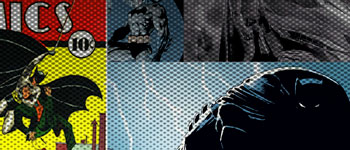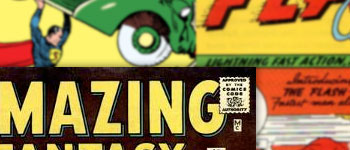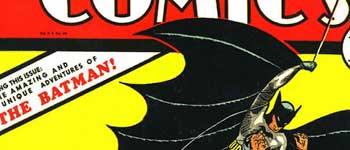
Dave & Adam's Premier Rewards Program
Level Up and Unlock automatic rewards with every dollar you spend
A Breakdown Of The New CGC Restoration Grading
While collectors have been restoring rare comics for ages, the Certified Guaranty Company (CGC) has reconditioned their grading scale for the classification of these comics. CGC's purple topped and shaded labels have symbolized a restored comic for awhile now, but the new iterations from July 1 and on will feature much more description.
The new restoration labels will provide comic collectors with more detailed information about the work done and the materials that were used in restoring the comic. Paul Litch, CGC Primary Grader, stated the following new CGC restoration scale is "a transparent system that is much more descriptive and accurate. We feel that it can really help people understand what was done to their book."
Before we begin talking about the changes, let's cover some restoration grading elements that haven't been touched: the ratings and liner notes.
The grading scale is the same 10 point scale (with 25 possible grades), ranging from 0.5 to 10:
Additionally, the liner note process is still alive (and actually enhanced a bit, as you'll see later). Of course, back in 2012, CGC launched grader notes that discuss problems and indicate the condition of the pages with detailed Grader Notes ranging from $5 to $15. Along with the liner notes, each comic has census data where you can see all available copies in existence, broken down by type: universal, signatures, restored, etc.
So, let's do a quick refresher on the pre-restoration scale attributes.
Pre-July CGC Restoration Scale Attributes
The previous scale for restoration included two main criteria (Quantity and Material) for the restoration of a comic, along with the grade from 1-10. Here's a look at how the previous system worked:
3 Point System for restoration quantity
- Slight
- Moderate
- Extensive
Material Designation:
- Amateur
- Professional
The final grade would then read with the grade as: Quantity Designation (Material Designation)
This means that a comic with slight restoration by a professional would be: Slight (P)
and extensive restoration by an professional would be: Extensive (P)
However, a new more comprehensive grading scale is upon us…
New CGC Restoration Scale
The new CGC restoration scale will now utilize a 5-point scale for quantity of restoration, and the material professionalism will now be broken into three categories.
5 Point System for Quantity Designation
- Slight (1)
All conservation work, re-glossing, interior lightening, piece fill no more than size of two bindery chips, light color touch in small areas like spine stress, corner crease, or bindery chip fill. Married cover or interior pages/wraps (if other work is present).
- Slight / Moderate(2)
Piece fill up to the 1/2" x 1/2" and/or color touch covering up to 1" x 1". Interior piece fill up to 1" x 1".
- Moderate (3)
Piece fill up to the size of 1" x 1" and/or color touch covering up to 2" x 2". Interior piece fill up to 2" x 2"
- Moderate / Extensive (4)
Piece fill up to the size of 2" x 2" and/or color touch covering up to 4" x 4". Interior piece fill up to 4" x 4".
- Extensive (5)
Any piece fill over 2" x 2" and/or color touch over 4" x 4". Recreated interior pages or cover.
Material Designation:
-
A - Excellent
The materials used in this classification can include:
- Rice paper
- Wheat paste
- Acrylic or water color
- Leafcasting
The color match needs to be near-perfect with no bleed through, and the piece fill has to be seamless with the correct thickness. Any filled edges should be cut to look even and the book needs to feel natural and have near-perfect staple alignment (or replaced exactly where they were). The staples should be cleaned or replaced with vintage staples. The comic cannot have fading, excessive whiteness, ripples, cockling, or ink smudges from cover or interior cleaning. The married cover and pages should match in size and quality, and be professionally attached.
-
B - Fine
The materials used in this classification can include:
- Pencil
- Crayon
- Re-glossing agent
- Piece fill from cadavers
Piece fills are obvious upon close inspection and obvious to the touch. Color touch is obvious upon closer inspection and any cover or page cleaning has created slight color fading or is excessively white.
Any professionally married pages or covers do not match in size and/or quality. The staple holes are enlarge/crooked or backwards, and the replaced staples are not vintage.
-
C - Poor
The materials used in this classification can include:
- Glue
- Pen
- Marker
- White out
- White paper on piece fills
Piece fills are obvious at arm's length, the color matching is bad, and the bleed through is evident. The cover cleaning has resulted in washed out/speckled colors, moderated cockling, or ripples. New staple holes were created upon reinsertion or non-comic book stapes were used.
Any kind of trimming was used and the married cover or pages were attached poorly with non-professional materials.
The rating will now be displayed as: Quantity Designation - Material Designation
Examples
A comic with moderate restoration with the highest level of materials used would be: A - 3
Even further, each type of restoration found in the book will be individually graded for quality and quantity.
This includes:
- Cover Cleaning
- Tear Seals
- Piece Fill
- Color Touch
The cumulative grade will use the highest (worst) letter and number grade that were used, all of which can be found in the grader notes.
So, if a comic features:
- Cover Cleaning: A-2
- Tear Seals: A-1
- Piece Fill: B-3
- Color Touch: C-2
The overall grade would become C-3, as the color touch had the worst letter grade (C) and the piece fill had the worst number grade (3).
And there you have it! Again, the quick new way to tell if a comic was graded under the new CGC restoration scale is to look for the Letter-Number combo underneath the grade. This new grading scale is much more granular and will be a boon for comic collectors worldwide!
To see the new grade in action, head over to our freshly graded Detective Comics #27 that used the new restoration scale. This comic book garnered the highest ever grade for the issue -- a 9.4 A-3 -- and we have a slew of high res images of the book itself to see the grading in action!
 1-888-440-9787
1-888-440-9787
 FREE Shipping on orders $199+
FREE Shipping on orders $199+
 FREE Gifts with orders $100+
FREE Gifts with orders $100+

 The Complete History of Batman
The Complete History of Batman
 The 20 Most Expensive Comics Ever
The 20 Most Expensive Comics Ever
 The Guide to Detective Comics #27
The Guide to Detective Comics #27